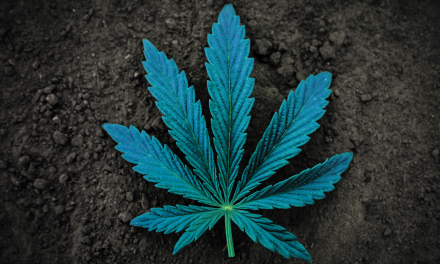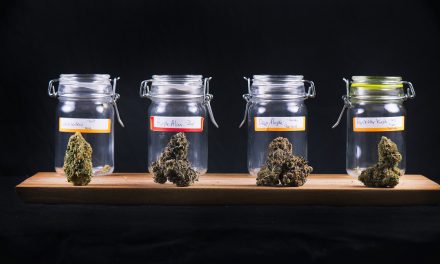Tetrahydrocannabinol, better known as THC, is the chemical responsible for the psychoactive effects of marijuana. According to the National Institute on Drug Abuse (NIDA), the chemical structure of THC is similar to a chemical found naturally in the brain called anandamide. Anandamide is a neurotransmitter that affects areas of the brain having to do with mood, memory, concentration, coordination, and perception. THC binds to this chemical and disrupts its function, causing the high that people experience when they consume the substance. Anandamide disruption causes lapses in memory, attention span, motor coordination, and pain sensations. THC also signals the release of higher levels of dopamine than natural, causing the euphoric feeling that people get when they consume the drug.
THC from the marijuana plant is used in two different ways, recreational and medicinal, and can be inhaled by smoking or vaping, or consumed when baked into foods. Those who use marijuana recreationally usually do so solely to enjoy the feeling of being high. However, according to AARP (aarp.com), those who draw on the drug medicinally use it to ease the symptoms associated with several health conditions, including chronic pain, insomnia, some mental illnesses (depression, anxiety, and PTSD), Crohn’s disease, and side effects associated with cancer treatment.
However, not all medical marijuana contains THC. Cannabidiol, or CBD, is the non-psychoactive chemical compound in the marijuana plant. Instead of a high, CBD promotes relaxation and relief from mild pain and anxiety. The difference between hemp and marijuana is that hemp has a higher concentration of CBD and a much lower percentage of THC than marijuana. Hemp oil, on the other hand, has neither THC nor CBD. Hemp oil is actually packed with healthy fats, making it a popular main ingredient in moisturizing beauty products. While CBD isn’t regulated by the Food and Drug Administration (FDA), there’s enough anecdotal evidence for the compound to have gained popularity in the health sphere. Epidiolex, the only CBD medication approved by the FDA, is used for the treatment of epilepsy seizures. Other reported anecdotes claim that CBD helps with back pain, anxiety, arthritis, insomnia, and even cancer.
Despite all the legitimate health benefits and non-recreational uses of the drug, there will always be people who smoke weed simply because they enjoy it. Seeing as though marijuana has grown more potent in the last four decades, this doesn’t come as a shock. According to the National Institutes of Health (NIH), the THC content of marijuana has tripled since 1995, going from 4 percent in the 90s to around 12 percent by 2014.
However, the levels of CBD in weed have dropped since then. It can be tricky to track the chemical content of older weed samples because the older they get, and if they’re improperly stored, the more the compounds within the plant degrade. Regardless, researchers seem to be in agreement that weed has become more potent over time, even if they don’t agree on the degree of said potency.
Regardless of potency, not everyone smokes the same amount of weed. Consequently, as marijuana is legalized and its usage enters the medicinal sphere, researchers will likely identify and promote specific dosages.
In states where recreational use of marijuana is legal at the age of 21, there is concern that underaged individuals will get their hands on the drug. Due to THC’s mind-altering effects, critics of cannabis legalization express concern over how weed might inhibit the developing mind. Additionally, the NIDA concludes that starting the habit of smoking weed while young might disrupt brain development.
As the adolescent brain continues to develop well into a person’s 20s, it’s susceptible to damage from all kinds of outside sources, including drugs. A 2013 study done at the University of Barcelona showed that teens and young adults who frequently used marijuana showed structural brain abnormalities and altered neural activity. Within heavy weed smokers, studies showed damage to the brain’s white matter, which is responsible for communication among neurons. Changes in white matter relates to increased impulsive behavior in people who started smoking before age 16. This is significant as the frontal cortex—which is responsible for planning, judgment, and personality—is the last part of the brain to develop.
Thanks to the rise of vape pens, teens have easier access to THC. While alcohol and other drug use among teens declines, the NIDA reports that vaping is steadily rising, stating that over 20 percent of 12th graders have vaped marijuana. However, even with vaping’s popularity, many teens don’t fully understand what it is they’re actually inhaling. Besides the THC itself, kids don’t know they’re also inhaling pesticides, ammonia, metals, additives, and carcinogens—the same substances that make cigarettes deadly. At the end of 2019, the Centers for Disease Control and Prevention (CDC) reported 2,172 vaping-related illnesses and 42 deaths tied to that number.
There’s also concern over the effects of marijuana use on a developing fetus. NIDA research concludes the use of marijuana by pregnant women leads to increased tremblings, a high-pitched cry, and altered responses to visual stimuli in newborn babies. As they grow older, children who were exposed to marijuana in utero show gaps in problem solving, memory, and attention span. However, more research is needed to control for other environmental factors that would also contribute to these issues, such as poverty, pollution, the mother’s overall health (mental and physical) during pregnancy, and possible use of other drugs or pharmaceuticals.
As marijuana use across the country becomes less and less of a taboo, an initiative to legalize recreational marijuana might appear on Missouri’s November 2020 ballot. According to the Missouri Secretary of State, people who are at least 21 years old may be able to legally use and possess up to one ounce of marijuana at a time. Additionally, those any age may also cultivate up to three marijuana plants at a time for personal use. The measure would also legalize the sale of weed and impose a tax on the substance. Those with non-violent marijuana-related charges would have their records expunged. Those currently serving time for said charges could also apply to have their sentences reduced.
Only time will tell whether attitudes toward marijuana use will continue to soften or if it will remain a taboo, despite its popularity and cross-country legalization. Additional research will continue to be poured into both the perceived health benefits of the plant and its risks. Until a consensus forms, however, it’s important to stay updated and educated on the continuous stream of information regarding marijuana and its use.








